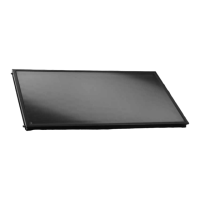2 x Product description
8
FA ROTEX Solaris - 08/2007
2.2 Brief description
The ROTEX Solaris system is a thermal solar system for supplying hot water for consumption and heating support.
Method of operation
The high-performance Solaris flat solar panels, types V21A, V26A and H26A convert the sunlight into heat with high efficiency.
Hereby, the heat transport media is normal tap water.
As soon as the solar panels have reached a useful temperature level, the water of the heating jacket in the storage tank (which
is not under pressure) is pumped directly through the solar panels. With insufficient solar panel temperature, the circulation pump
is switched off and the system is drained automatically. This method has several advantages:
– High operational reliability, as no components that could be damaged (such as expansion vessel, safety valve, venting valves,
etc.).
– Excellent heat transfer and heat storage capacity (system works without antifreeze agents).
– Minimum maintenance requirements.
– Frost proof.
– Without separate solar heat exchanger.
Modular design
The system consists of several preassembled modules. Plug-in technology and a high degree of pre-assembly ensure fast and
simple system installation.
Storage container
The following storage containers can be used for the ROTEX Solaris system:
– ROTEX Sanicube Solaris: Thermally insulated, non-pressurised plastic storage tank.
– ROTEX Gas Solar Unit (GSU): Sanicube Solaris with integrated gas condensing boiler.
– ROTEX E-Solar Unit (ESU): Sanicube Solaris with integrated electric water heater.
Electronic control
The fully electronic control unit ROTEX Solaris R3 ensures optimum utilisation of the solar heat (hot consumption water
generation, heating support) as well as the observance of all safety-relevant aspects. All parameters needed for trouble-free
operation have been preset at the factory.
Construction, operating principle, commissioning and operation of the storage container are not described in this
manual. Detailed information on the storage containers is given in the manuals of the respective units.

